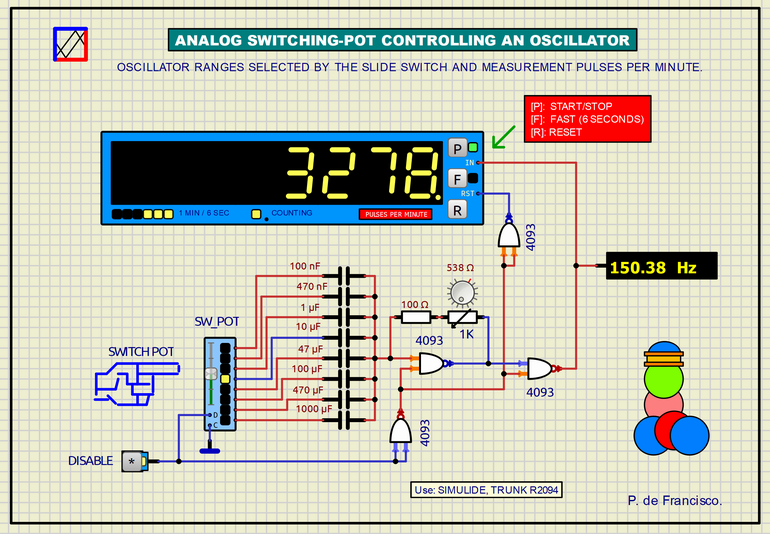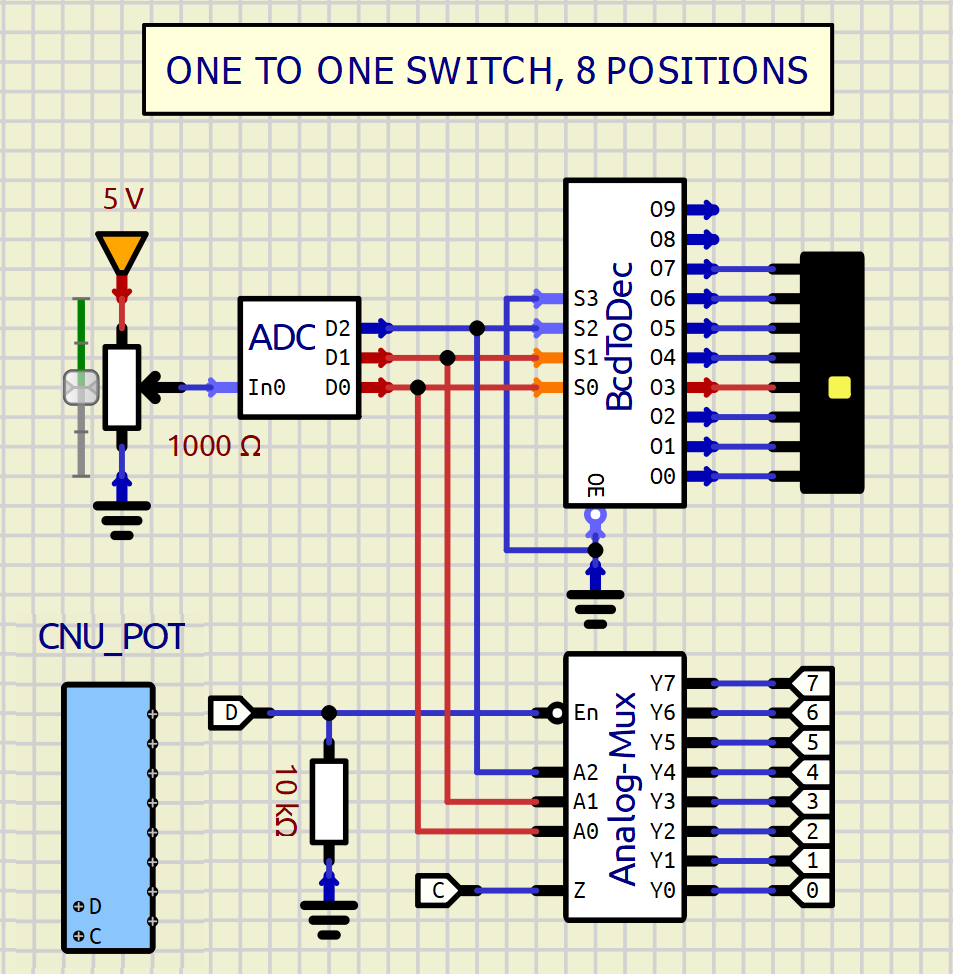342__SLIDER ANALOG SWITCH CONTROLLER
Quote from Defran on January 2, 2024, 9:44 am
342_SLIDER ANALOG SWITCH CONTROLLER. (SIMULIDE R2094 or higher.)
This example is composed of a Schmitt-type oscillator made with a 4093 NAND CMOS gate. The 1k potentiometer varies the frequency linearly and with a set of capacitors is gets up to 8 ranges. These ranges are switched manually using an analog switch operated by a slider. The output of the oscillator is applied to a module pulses per minute counter integrated by a subcircuit.
CONTROLS:
a) DISABLE: Pressed activates the oscillator.
b) SW_POT: By moving the slider you can switch between eight capacitors of stepped values.
c) 1K POTENTIOMETER: Linearly adjusts the frequency within each range.
d) SUB-CIRCUIT CONTROLS "PULSES PER MINUTE": Use functions described in the diagram itself. On the body of this device 8 LEDs show the measurement time: 1 minute for maximum precision according to command [F] and 6 seconds in fast mode for a quick approximation reading. An output with "Counting" LED gives a high level during the measurement time. This output can be used for others applications.SUBCIRCUITS.
This example integrates several subcircuits located in the "data" folder in the Zip attached. This folder must always be next to the "sim1" scheme so that it can be executed.
Internal diagram of the analog slider switch (Made of Simulide primitive functions):
a) ADC: 3-bit digital analog converter from the analog level to its output.
b) DECODER 3 TO 8 to show the position of the cursor on LED.
c) MUX: 3-bit analog multiplexer input of the internal ADC bus. This MUX one has a disable input.
A subcircuit is a “custom” circuit that accumulates a set of Simulide base components (primitive function) to obtain a new or an adapted function. These subcircuits are treated by Simulide as another component of its own structure. User can create his own subcircuits or use the ones published here in your own designs once the procedure is known, explained in detail in the Simulide tutorials: https://simulide.com/p/subcircuits/
* Communication with the author: Simulide/User/Messages/Defran
P. de Francisco.

342_SLIDER ANALOG SWITCH CONTROLLER. (SIMULIDE R2094 or higher.)
This example is composed of a Schmitt-type oscillator made with a 4093 NAND CMOS gate. The 1k potentiometer varies the frequency linearly and with a set of capacitors is gets up to 8 ranges. These ranges are switched manually using an analog switch operated by a slider. The output of the oscillator is applied to a module pulses per minute counter integrated by a subcircuit.
CONTROLS:
a) DISABLE: Pressed activates the oscillator.
b) SW_POT: By moving the slider you can switch between eight capacitors of stepped values.
c) 1K POTENTIOMETER: Linearly adjusts the frequency within each range.
d) SUB-CIRCUIT CONTROLS "PULSES PER MINUTE": Use functions described in the diagram itself. On the body of this device 8 LEDs show the measurement time: 1 minute for maximum precision according to command [F] and 6 seconds in fast mode for a quick approximation reading. An output with "Counting" LED gives a high level during the measurement time. This output can be used for others applications.
SUBCIRCUITS.
This example integrates several subcircuits located in the "data" folder in the Zip attached. This folder must always be next to the "sim1" scheme so that it can be executed.
Internal diagram of the analog slider switch (Made of Simulide primitive functions):
a) ADC: 3-bit digital analog converter from the analog level to its output.
b) DECODER 3 TO 8 to show the position of the cursor on LED.
c) MUX: 3-bit analog multiplexer input of the internal ADC bus. This MUX one has a disable input.

A subcircuit is a “custom” circuit that accumulates a set of Simulide base components (primitive function) to obtain a new or an adapted function. These subcircuits are treated by Simulide as another component of its own structure. User can create his own subcircuits or use the ones published here in your own designs once the procedure is known, explained in detail in the Simulide tutorials: https://simulide.com/p/subcircuits/
* Communication with the author: Simulide/User/Messages/Defran
P. de Francisco.
Uploaded files: